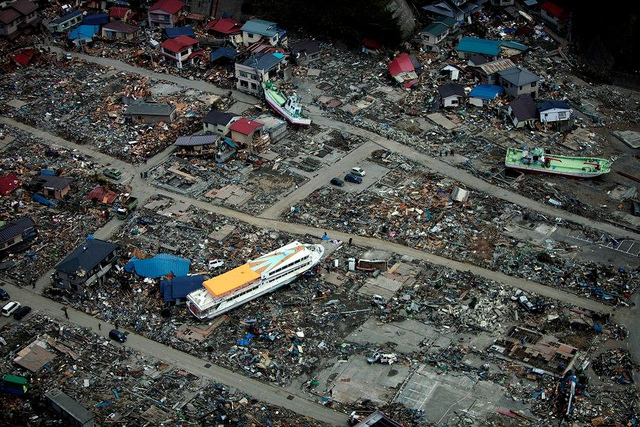We Can Handle a Hurricane or Tornado, But What About a Mega-Disaster?

What would happen if an event like the 2011 tsunami in Japan happened in the US? Image Credit: (U.S. Marine Corps photo by Lance Cpl. Garry Welch/Released)
Summer is natural disaster season. Hurricanes and tornados make their destructive way across the country with a fairly regular timing, and people who live in their wake know—more or less—how to deal with them. But what if something really bad happened, something even worse than a hurricane or tornado? An expert panel at the American Geophysical Union’s Science and Policy conference thinks that the United States isn’t prepared for some of the curveballs Mother Nature can throw at us.
Think, for instance, of the long series of rainstorms that flooded California in late 1861 and early 1862. This wasn’t just some one-off hurricane: the rain lasted for 45 days, and Sacramento was swamped under ten feet of water. The rains were caused by an “atmospheric river” that brought moisture-laden air up from the Pacific towards California’s Central Valley. The USGS issued a report in 2010 that talked about what it would be like if that scenario happened today, and it’s not pretty:
In many cases flooding overwhelms the state’s flood-protection system, which is typically designed to resist 100- to 200-year runoffs. The Central Valley experiences hypothetical flooding 300 miles long and 20 or more miles wide. Serious flooding also occurs in Orange County, Los Angeles County, San Diego, the San Francisco Bay area, and other coastal communities….
Hundreds of landslides damage roads, highways, and homes. Property damage exceeds $300 billion, most from flooding. Demand surge (an increase in labor rates and other repair costs after major natural disasters) could increase property losses by 20 percent. Agricultural losses and other costs to repair lifelines, dewater (drain) flooded islands, and repair damage from landslides, brings the total direct property loss to nearly $400 billion, of which $20 to $30 billion would be recoverable through public and commercial insurance. Power, water, sewer, and other lifelines experience damage that takes weeks or months to restore.
Or what about tsunamis? In the United States, we’re just not ready. But we could be if we looked at how other countries manage. From NPR:
Even Japan, which has been preparing for tsunamis for decades, was overwhelmed by the damage to coastal cities, says Eddie Bernard of the National Oceanic and Atmospheric Administration. The event “exceeded their capacity to recover because in many cases the city was washed away,” he says, adding that tens of thousands of people who lost their homes are still living in government housing.
But the result would have been much worse in the U.S., Bernard says. “Japan was much better prepared, and they are recovering much easier than perhaps we would because they’ve thought this thing through,” he says. For example, roads were restored in weeks, and communities that survived had electricity again within 10 days, he says.
A government study found that if a similar tsunami struck the coast of Oregon, some areas would be without electricity for months and without water for more than a year.
And those aren’t even the worst mega-disasters imaginable. What about if something really unusual happened, like an asteroid impact? The meteorite that burned up over Russia a few months ago left 1,000 injured and had a shockwave that travelled around the world twice—but it was tiny compared to some of the massive debris floating in space. In a Congressional hearing earlier this year, former astronaut and asteroid hunter Ed Lu was asked what would happen if an asteroid a kilometer in diameter hit the earth. His reply was simple: ”That is likely to end human civilization.”
More satellites and observatories for near-earth objects could give us a few years notice and enough time to come up with contingency plans. But those kind of monitoring systems cost money, and that sort of funding requires either Congressional approval or a massive private fundraising campaign. (Of course, there are already some insanely awesome asteroid-capturing ideas out there, but they would still require someone to pay for them.) The U.S. isn’t the only country struggling with these preparedness issues, but one thing’s for sure, if the next big disaster hit tomorrow, we wouldn’t be ready.
More from Smithsonian.com:
Nearly Every American Has Had to Deal With Some Weather Disaster Since 2007
Could The Sun Set Off The Next Big Natural Disaster?
Asteroid Hunters